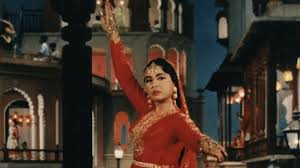Kotha v/s Kothi:Ashok Kuumar and Meena Kumari lived contrasting lives. Both resided in sprawling mansions but while Kumar’s was a feudal setup, Kumari belonged to the tawaifs who come evening dressed up in fineries and entertained guests. The nautch girls had a life before dusk.Unlike the kotha the women in nawab homes had no voice and moved freely only when the patriarch was away. In his presence they went behind veils and remained invisible until summoned. What is common between the two was the cultures or the tehzeeb and Kamal Amrohi portrayed both with utmost pomp and glamour. The concluding scene where the two worlds come together in a wedding and a funeral and Nawabjaan/ Veena breaks down it is done in dignity and Sapru full of remorse mourns in silence.
Mujra v/s Melody: To a great extent the beauty of Pakeezah is associated with its poetry and melody. The haunting background score of maestro Naushad Ali and Ibrahim and combined muse of stalwarts Majrooh Sultanpuri, Kaifi Azmi, Kaifi Bhopali and Kamal Amrohi’s lyrics set to music by erstwhile Ghulam Mohmad are songs for a lifetime. A team of choreographers came together to ensure that every mujra was distinctly different so while ‘Inhi logo ne…’ and ‘Thade rahiyyo…’ by Lachu Mahrajj concentrates on abhinaya, Gauri Shankar’s ‘Chalte chalte…’ is about footwork and ‘Aaj hum apni duaaon…’ about pherras in Kathak dance form. Meena Kumari even though grossly overweight and untrained in classical dance through intricate mudras and mercurial expressions added the navrasas essential to play the eternal seductress in a glittering mehfil of admirers. ‘Mausam hai aashikana’ is not a mujjra but melody at its peak.
To be continued…
@bhawanasomaaya
